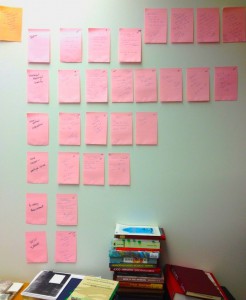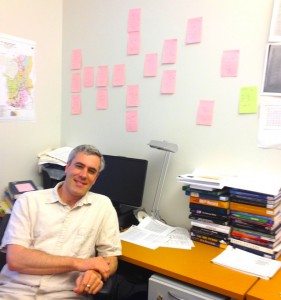Every article, book, or thesis begins with a first word, but getting started feels overwhelming. My worst prose derives from disorganized thinking and writing, and over the years I’ve experimented with different systems to help me get my projects off the ground. When I map out some incremental steps, my projects seem more manageable.
First I ask myself: what do I want (or need) to write? This helps determine the best format for my research results. In some cases the format was predetermined for me – when I was a doctoral student I had to produce a dissertation of a certain minimum length. When I write for a journal, they enforce specific word counts. These days, I have a bit more freedom, but I still struggle to determine if I have a book length argument or if my research is best presented as a series of articles.
Before I write the first sentence, I try to visualize the contours of my project. I once typed up outlines, but now I imagine less formal ways to physically manifest a project. At the outset, I spend hours examining my research, beginning to define the distinct sections or chapters. I need a concrete guide that will help me tackle the writing tasks necessary to get from the first to the last word of the project.

This initial visualization of a project helps me find the right medium for the research. Do I have one or two key points to make? If so, can I substantiate them with a few well-chosen ethnographic examples or will these points require lengthy contextualization and multiple examples? Ethnographic articles must be succinct and therefore suit arguments that can be stated, contextualized, and substantiated within about 10,000 words. If I need more space, I either break up the argument into smaller arguments and write two or more articles, or consider expanding them into a book.
When I wrote my dissertation, I kept a large, three-ring binder that would eventually contain my final thesis. I created divider tabs for each of the imagined chapters, and inserted the relevant materials and fieldnotes into the binder where I thought they belonged. Sometimes, I included blank pages as stand-ins for unwritten sections. As I reorganized my writing, the physical process of moving pages from one section to another helped me think through the final contours of the thesis. I reproduced this method when transforming the dissertation into The Red Riviera.
When writing Muslim Lives in Eastern Europe, I was on sabbatical and had accepted a residential fellowship at the Institute for Advanced Study. I had an empty office with bare bookshelves. I divided this blank shelf space into imaginary chapters, taping the name of each chapter under each space, and created piles of paper associated with each chapter, moving things from pile to pile as needed. When I sat down to write a particular chapter, I would pull down the pile of documents and have everything I needed beside me on my desk. “Piling” proved more efficient than “filing.”
I wrote the first full draft of The Left Side of History on a summer fellowship in Cambridge, Massachusetts. I wanted the book to have a greater number of shorter chapters so I wrote all of the chapter subjects on index cards and stuck them to the wall over my desk with sticky blue tack. I could move the pieces of the book around with ease. When I cut chapters, I removed their index cards, and rearranged the remaining cards on the wall. At the end of the day, I poured a glass of wine and meditated on the cards, wondering how best to assemble the chapters into a coherent whole.
The dividers in the three-ring binder, the chapter shelves, and the index cards all correlated with individual document files on my computer. For each imagined chapter, I create a new document file and keep these together in a folder. In the electronic folder, I can move the individual files around in different orders (by starting each document file name with a number, for instance) until I find the ideal flow for the narrative.
While I worked in Cambridge my colleague, the cultural anthropologist Doug Rogers, was finishing up his fellowship year at the Radcliffe Institute for Advanced Study. Doug arrived in Cambridge with his research and fieldwork already done, and used the software program Scrivener to produce the first draft of his new book manuscript. He said that the Microsoft Word interface was too familiar, and he found himself tempted to start self-editing when he used it to generate new prose.

According to Doug, Scrivener allows you to organize your writing into chapters and subsections within one file. All of this can be easily moved around and rearranged on a side menu without all of the scrolling up and down and cutting and pasting required in a long Microsoft Word document. Scrivener also has a window where you can see the footnotes linked to your text off to the side of your document. You can upload research materials, and attach them directly to the relevant chapter or subsection. Then you can work in a split screen mode where your text is open on top and the research article you need is open on the bottom.
Doug also transferred the organizational structure provided by Scrivener onto the walls of his office. He used Post-It memo notes to physically map out his chapters, surrounding himself with the outline of his book as he wrote it. If he ended up moving sections of text around in the manuscript, he could rearrange the Post-its on his walls to reflect the new ordering. When I walked into Doug’s office, it felt like I was walking into Doug’s book.
I am convinced that visualizing techniques like these provide enhanced mental clarity when dealing with a large body of research to be organized into a coherent narrative. They also give you an incentive to start writing.
0 thoughts on “Ethnographers as Writers: Getting Started”